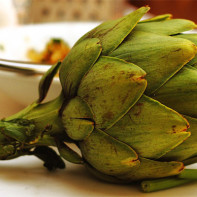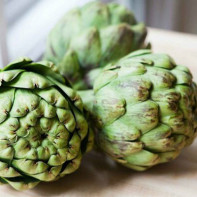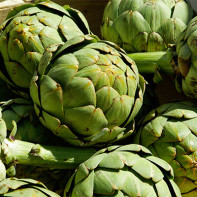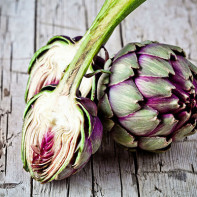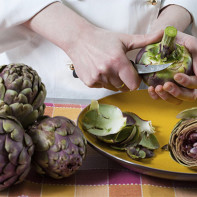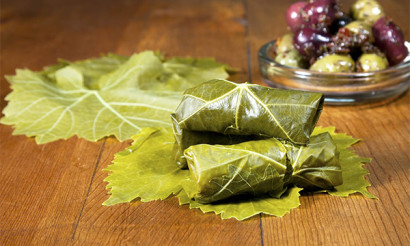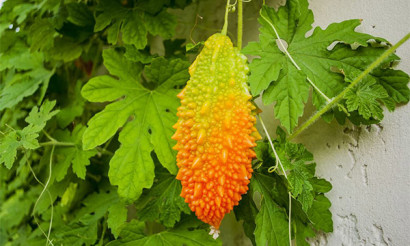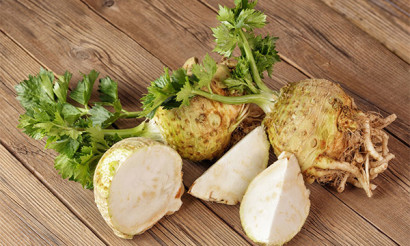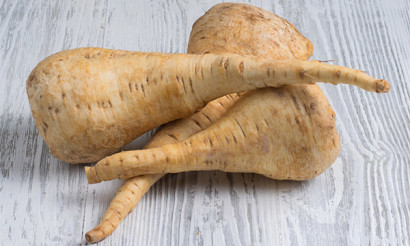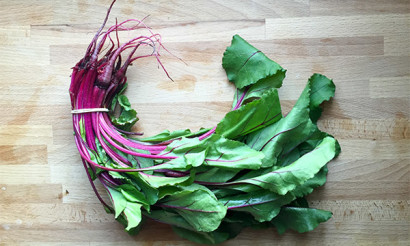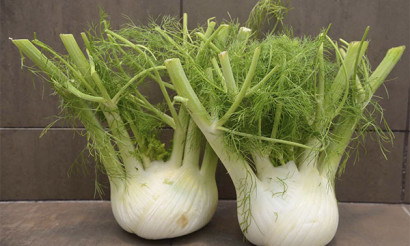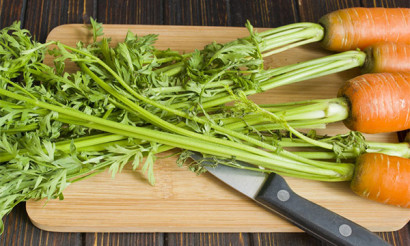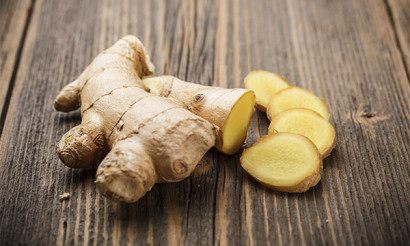Artichoke: health benefits and harms
An artichoke is a vegetable plant whose genus has more than 100 different varieties. 40 varieties of this crop are grown for food. It is a dietary vegetable, many consider it a delicacy. In our country, few people know about him, but the French, Spaniards, Italians and Greeks know almost everything about him. The plant is widely used in the cuisine of most European countries.
- What is an artichoke and how does it look
- Kinds
- Composition and calorie content
- Useful properties of artichoke
- General benefit
- For women
- For men
- During pregnancy
- When breastfeeding
- For kids
- When losing weight
- Is artichoke tea good for you?
- What is useful extracts from artichoke
- How to use
- Artichoke in medicine
- With diabetes
- With pancreatitis
- With gastritis
- For constipation
- With gout
- For the liver
- With cholecystitis
- Traditional medicine recipes with artichoke
- Infusion
- Decoction
- Artichoke Tea
- Juice
- Tincture
- Application in cosmetology
- For face
- For hair
- Harm and contraindications
- How to choose and store
- How to eat artichoke
- What can be prepared from artichoke: recipes
- Boiled dish
- Artichoke salad
- Artichoke in sauce
- Roman artichoke
- Baked artichoke
- Fried artichoke
- Interesting Facts
What is an artichoke and how does it look
Artichoke is a unique vegetable culture with a lot of healing properties. It is especially popular with nutritionists and is widely used in nutrition. In pharmaceuticals and cosmetology, a number of medical and cosmetic preparations are produced on its basis.
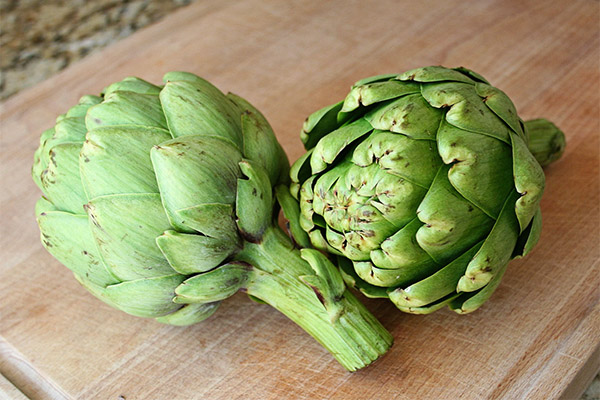
Vegetable culture loves a lot of sun, an arid climate is acceptable for it. For this reason, in our country, a plant is rarely seen. It mainly grows in countries with hot climates. Artichoke is grown in many European countries. You can meet grassy culture in Ukraine.
In cooking, plants use baskets, which are represented by flower buds. This is a kind of community of fleshy scales resembling hop cones or walnuts, 11 cm in diameter.
The Vietnamese use leaves with roots and stem to make tea. For cooking, baskets are used. They can be eaten fresh or boiled. Many gourmets prefer pickled artichoke. The finished dish from a herbaceous plant has an incomparable taste.
Kinds
In our country, while a vegetable is considered a delicacy, while in Greece it is a common everyday culinary dish. Culture has a long history. For more than 5,000 years, the ancient Greeks and Egyptians used the artichoke as a medicine. Only the Spanish form is eaten.
If you translate the name from Latin, it will mean "dog". People called it that way because of the appearance, since unbroken buds are somewhat reminiscent of a dog’s teeth. And if you translate the word artichoke from Arabic, it will mean "earthen prickle".
The plant came to Russia during the reign of Peter I. It was mainly used as a decorative culture.
There are two main types of plants: Spanish and prickly. This is a perennial culture, about 2 m high, which has a core root and a straight stem. The color of the plant is pale green, slightly grayish. It has dissected cirrus leaves. The plant is very beautiful, with large purple or blue flowers. When the culture begins to bloom, then its appearance is very similar to a thistle.
A cultivated or Spanish species is grown for consumption. The herb is rich in vitamins, micro and macro elements, carotene, minerals, thiamine and other valuable substances.
Leaves of culture are used as raw materials for the manufacture of medicines. They are recommended to be used to reduce excess weight, as a biological supplement, etc. The vegetable is not high-calorie, therefore it is considered dietary. Eating a plant can make up for the lack of vitamins in the body.
Composition and calorie content
Inflorescences of vegetable crops contain:
- ascorbic acid;
- tannins;
- carotene;
- fatty acid;
- essential oils and more.
Of the vitamins, groups B, C, E, K, A, etc. can be distinguished. It contains a lot of:
- polysaccharides;
- cinarosides;
- glyceric acid, etc.
In addition, the plant has a lot of protein, fiber and carbohydrates. From micro and macro elements can be distinguished:
- copper;
- selenium;
- zinc;
- magnesium;
- iron;
- calcium;
- phosphorus;
- potassium;
- sodium and others
If we talk about leaves, then they have a sufficient amount of various acids:
- Coffee
- glycerin;
- chlorogenic;
- glycolic;
- neochlorogenic and others.
In addition, the leaves contain flavonoid glycosides, inulin, etc.
Important! It is worth knowing that the plant contains a lot of folic acid, which is vital for the human body.
If we talk about calories, then this vegetable crop will be only 28 kcal. This is based on 100 g of product. Even when cooked, the calorie content will not exceed 53 kcal, so the vegetable will be indispensable for people who are trying to lose extra pounds. The use of this plant will help to reduce weight, without prejudice to your health, since the vegetable will enrich the body with all the necessary valuable elements due to its composition.
Despite the low calorie content of the plant, it has a sufficient amount:
- carbohydrates;
- fats;
- proteins;
- water;
- fiber;
- dietary fiber.
Useful properties of artichoke
General benefit
Even the ancient Egyptians and Greeks healed sick artichokes. This is an ancient culture, and its “miraculous” properties were known even 5,000 years ago. They were treated for scurvy, rheumatism, heart disease, liver pathology, edema.
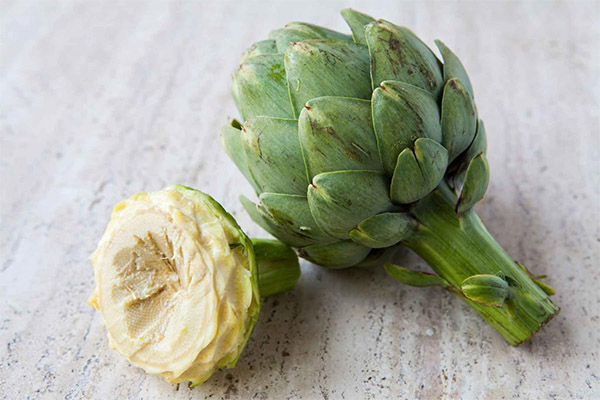
He was advised to use with jaundice, was prescribed for gout. Current doctors do not deny the uniqueness of the vegetable. Medicine confirms that the plant has many useful properties, such as a diuretic effect, and is also able to excrete bile. The value of culture was appreciated by traditional healers. Due to the presence of inulin, the vegetable can be eaten by diabetics.
The consumption of artichokes positively affects the digestive system, so it is useful to take it in case of poisoning with drugs, alcohol or food. Decoctions or tinctures from a vegetable culture contain a lot of sodium and potassium, which lower acidity, which is especially important for patients with gastritis.
This is a unique culture with a rich chemical composition. Experts recommend it to people suffering from kidney and liver diseases. Preparations based on a herbaceous plant are prescribed for hepatitis, nephritis, cholecystitis and even cirrhosis. This is an excellent tool to restore the body after taking a large number of antibiotics.
Medicinal decoctions are prepared from the leaves of a herbaceous plant. They help lower cholesterol, remove uric acid. In the old days, decoctions were drunk to reduce the smell of sweat, and also used to rub into skin from baldness. Teas that normalize the function of the digestive tract are also useful.
The healing properties of the herbaceous culture are used in pharmaceuticals to treat allergies, urolithiasis. Plant extract is used to relieve toxic effects on the body.
We list the main beneficial effects of the artichoke:
- cleanses the liver;
- removes toxins from the intestines;
- improves cerebral circulation;
- cleanses the kidneys;
- improves digestion;
- lowers sugar levels;
- relieves the symptoms of allergic reactions;
- beneficial effect on hair growth, appearance of skin and nails.
Inflorescences of grassy plants have the following healing properties:
- vasodilator;
- choleretic;
- hypocholesterolemic;
- diuretic;
- antihepatotoxic;
- antitoxic.
Despite the usefulness of the vegetable, its use, especially for people suffering from chronic diseases, should be careful. He has contraindications, so before including the plant in your diet, you need to get advice from your doctor. The same goes for artichoke-based medications.
For women
For a woman’s body, culture will be very beneficial.Eating a plant for food will reduce the risk of possible occurrence of cancerous tumors, including mammary glands. The artichoke normalizes blood pressure in the pelvic area, helps with conception. Dishes or preparations based on vegetables are recommended by sexologists, as they enhance sexual activity.
Culture is good for maintaining and preserving youth and beauty. Thanks to the folic acid that is part of it, and in sufficient quantities, a woman can prevent skin aging, reduce the number of wrinkles. Acid perfectly regenerates the skin and rejuvenates the appearance.
With the help of a vegetable, you can reduce and even completely eliminate increased sweating.
For those who follow their figure, the use of a herbaceous plant will be indispensable. This is a low-calorie product, even when boiled. It will not give a burden on the stomach, but will saturate the body and enrich it with useful elements. With its help, it is easy to get rid of extra pounds.
For men
The stronger sex will undoubtedly appreciate the grassy culture. It is recommended for prostatitis. Sexologists advise taking it to enhance sexual desire and potency, so it will be useful for men suffering from these problems to eat an artichoke. Doctors prescribe medications based on this plant for adenoma.
During pregnancy
Women during pregnancy require a lot of vitamins and minerals. Artichoke consumption can saturate the body with valuable substances and help cope with toxicosis. To form a developing fetus, a future mother needs folic acid. This component in the artichoke is enough. Due to the use of a plant or medicinal products based on it, it is possible to avoid abnormal development of the fetus or some defects and ensure its proper formation. Yes, and other useful elements contained in the vegetable culture will be useful to a pregnant woman.
When breastfeeding
Artichoke during lactation is contraindicated. Despite all its positive qualities, it is able to negatively affect the production of milk in the breast of a nursing mother. Therefore, it is not worth the risk, it is better to abandon its use during breastfeeding.
For kids
An artichoke can be given after 12 years of age. Until this time, you should not feed them children. It can cause indigestion, bloating, flatulence and other unpleasant moments. But after 12 years, you can try to give the child a small amount of vegetable and look at his reaction. If there are no side effects, then gradually the dose can be increased.
When losing weight
For weight loss, the artichoke will be indispensable. It contains fiber, which accelerates the process of burning fat. This is one of the suitable plants for people seeking to lose extra pounds. It helps the body cleanse itself, remove excess fluid and process fats. The artichoke cannot completely destroy them, but it is able to modify them so that they are eliminated faster. But this does not mean that it is necessary to sit on the same artichokes for several days. In no case! This is just a great supplement and weight loss supplement.
Is artichoke tea good for you?
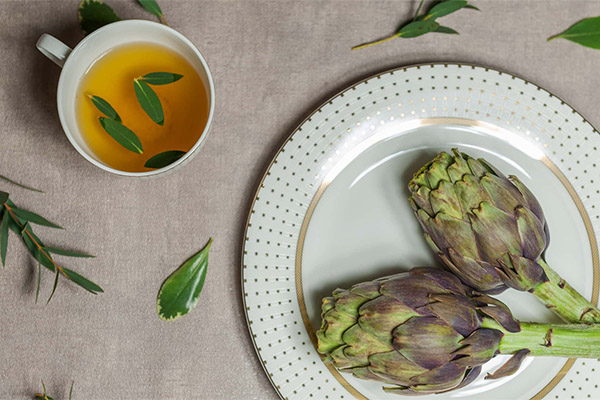
We highlight the main advantages of artichoke tea:
- possesses antibacterial properties;
- tones up;
- lowers sugar levels;
- prevents the development of infectious diseases;
- cleanses the skin;
- removes toxins;
- relieves puffiness;
- breaks down fats, which helps to get rid of extra pounds;
- lowers blood pressure;
- Soothes the stomach, relieves nausea and heartburn.
We mentioned only part of the positive aspects of artichoke tea. But there are many more. Drink it in moderation in order not to harm the body. Excessive use of it can negatively affect human health. Remember that everything should be in moderation.
What is useful extracts from artichoke
Specialists often advise patients to use a hood. The extract is included in many drugs and dietary supplements. This is a choleretic drug that has a beneficial effect on the liver.It can be taken in parallel with antibiotics. So the liver will be protected from constant medication.
The extract is able to burn internal fats, so people who are obese often turn to it.
How to use
The extract is available in capsules and tablets. Dose per day - no more than 25 ml. Take 20 minutes before meals three or two times a day.
The course of treatment is usually 14 days, but may take up to a month. Then you should take a break for a month or two and repeat the treatment.
Artichoke in medicine
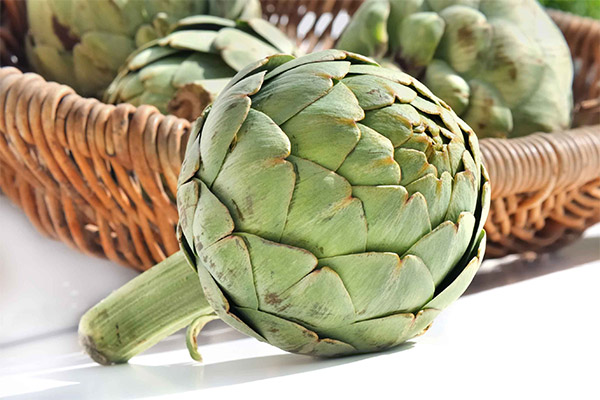
With diabetes
Dishes prepared from artichoke are advised to patients with diabetes. Since the vegetable contains substances that replace sucrose, consumption of the crop will be beneficial for diabetics. In addition, a cultivated herb will help normalize blood glucose levels.
Important: the glycemic index of the artichoke is 30 units.
With pancreatitis
Artichoke patients with pancreatitis can eat. This will diversify their diet and give them several positive points:
- Reduces acidity.
- It will reduce cholesterol, speed up metabolic processes in the body thanks to the inulin contained in the plant.
- Facilitates the processing of fats.
- Relieves cramping due to anti-inflammatory properties.
- Protects the liver from negative influences and normalizes the work of the body.
- Reduce flatulence and flatulence.
- Relieve heartburn, nausea, heaviness in the stomach.
Worth to know! It is strictly forbidden to consume a grassy culture during the period of exacerbation! Despite its low calorie content, a vegetable can adversely affect health and further inflame a diseased gland.
With gastritis
Patients with gastritis are not forbidden to use the artichoke, but not during the period of exacerbation. Be sure to consult your doctor and determine the dosage together. Note that with gastritis, you should not eat canned vegetables. It will be better if you make mashed potatoes from artichoke or try the product fresh.
For constipation
With constipation, it is better to use not the artichoke itself, but its juice. There is one recipe that will help get rid of bloating and delayed feces. You need to take some juice and mix it with egg yolks. Then mix everything thoroughly and drink the mixture in the evening before bedtime.
The artichoke accelerates metabolic processes, so its regular use will relieve digestive problems.
With gout
Since the plant is able to remove harmful substances from the body, including salt deposits, the vegetable will be especially useful in the treatment of gout. In folk medicine, there are several recipes for patients with gout.
- Grind with a blender or mince a few buds through a meat grinder. It is worth choosing only fresh plants. To prepare the drug, it will take only 200 g. Grind a couple of cloves of garlic or pass them through a garlic squeezer. Mix everything and add a little honey. Take this mixture for 2 months, then take a break and start treatment again.
- You can cook a decoction. To do this, take 500 g of fresh buds, pour them with boiling water (3 l) and put to boil. Cook for 20 minutes. Take out the swollen buds and chop them. Add finely chopped burdock leaves to them. Such a composition is applied to the joint and held for an hour. The water remaining after cooking the artichoke can be added to the bath.
For the liver
An artichoke for patients suffering from liver diseases is just a godsend! The plant is able to not only improve the cells of a diseased organ and normalize its work, but also reduce the amount of bile. Vegetable recommended for hepatitis in acute and chronic form, jaundice, and even with cirrhosis.
This is an excellent organ cleanser. Doctors recommend taking it regularly to people with bad habits (smoking, drinking alcohol), as well as those who are undergoing chemotherapy. The plant relieves a hangover.
Artichoke is allowed in the postoperative and preoperative period.
With cholecystitis
Artichoke helps patients with cholecystitis. He not only has choleretic properties, but also is able to relieve nausea. According to reviews published on the Internet, patients with regular consumption of vegetables forget about discomfort and severity.
Traditional medicine recipes with artichoke

Infusion
- Grind 2 teaspoons of inflorescences of herbaceous crops and put them in a separate bowl.
- Fill everything with boiling water (250 ml) and cover with a lid.
- We warm and let cool a little.
- We filter.
Take the infusion should be half an hour before meals, half a glass 2 times a day, you can three times a day.
Decoction
- Tear off the leaves of the plant in an amount of 40 g.
- Pour them with boiling water and put on a slow fire.
- As soon as the water boils, cook for another 10 minutes.
- Remove from heat and let it brew, covering it with a lid.
- As soon as the water becomes warm, filter.
Such a decoction is suitable for external use in the form of lotions and wipes.
Artichoke Tea
- We prepare the grass and grind it. To make tea, 2 teaspoons will be enough. You can use not only leaves, but also stems.
- Pour boiling water over everything and cover with a lid.
- We insist 7 minutes.
- Add sugar or honey to improve the taste. All at the discretion of the hostess.
Juice
To make juice, we need baskets.
- Grind the baskets with a blender or pass them through a meat grinder.
- Put everything in gauze and squeeze the juice.
- Keep in the refrigerator.
Tincture
For cooking, we need:
- leaves of grassy culture - 250 g;
- alcohol 70% - 0.5 l (if there is no alcohol, then you can use vodka).
Cooking:
- Grind the leaves.
- Fill with alcohol or vodka and tightly close the container with a lid.
- We put in a dark place and insist 14 days. The temperature should be room temperature.
- Shake the bottle daily.
- After the time has passed, filter the tincture, and squeeze the remaining.
Take as follows: 1 tablespoon of tincture diluted with water (100 ml). This is considered a single dose. Drink three times a day.
Application in cosmetology
In cosmetology, a herbaceous plant is used to make various moisturizing masks, creams, and mixtures. Such compositions are suitable for application to the entire skin surface. The skin becomes elastic and smooth, saturated with useful elements and rejuvenated. The peculiarity of preparations based on vegetable culture is that the effect of its use is immediately visible.
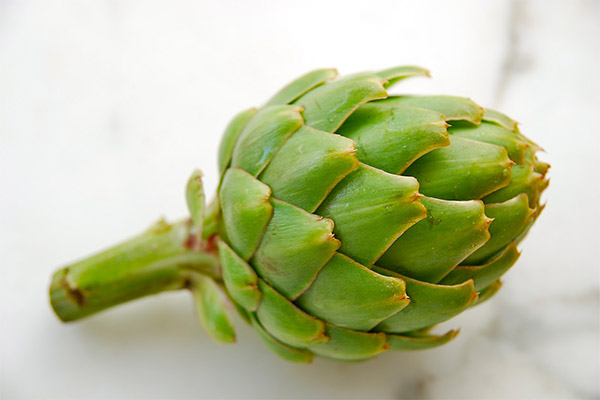
For face
- Universal. This mask refreshes and rejuvenates the skin, makes it radiant. To prepare it, we need 4 artichokes. Cook them for 30 minutes. As soon as they soften, knead the vegetables. Add two yolks and 1 teaspoon of aloe juice. Mix everything thoroughly. We apply the prepared composition to the face and leave for 20 minutes. Wash off with warm water.
- For oily skin. Such a mask can remove fat and eliminate acne. Suitable for mixed skin. To prepare the mask, boil 4 artichokes for 20 minutes. It is important that the vegetables become soft. We take them out of the water and knead. You can use a blender to get a homogeneous mass. Cool and add 1 teaspoon of aloe juice to artichokes. Apply on face for half an hour. Wash off with warm, but not hot water. To improve the effect, rinse your face with cold water. This mask can be used in 7 days 2 times.
- Artichoke lotion. This composition is suitable for daily rubbing of the skin. Finely chop 100 g of artichoke leaves and fill them with high-quality vodka in an amount of 100 ml. We insist 4 weeks. As soon as the tincture is ready, we dilute it with boiled, cooled water. It is better to dilute with water before wiping. The proportions are as follows: 1 teaspoon of tincture in ½ cup of water.
- For dry skin. We prepare a decoction of chopped vegetable leaves. The recipe is very simple. Cut the leaves and pour them with boiling water. We insist half an hour. Everything, the broth is ready, they can be washed to remove dryness from the skin.
- Anti-aging mask. To prepare, you will need either inflorescences of a grassy culture, or leaves. Grind them. We take 2 tbsp. tablespoons of crushed plants and mix with 2 tablespoons of liquid honey. Add the same 2 tbsp. tablespoons of sour cream or cream.Mix everything thoroughly and smear the face and neck with the resulting composition. We stand for 15 minutes and remove the mask with a damp cloth. Then rinse your face first with warm and then cold water.
For hair
- Recovery. Boil 4 artichokes for 20 minutes and mash them. This can be done using a blender, the main thing is that the mixture is homogeneous. Add kefir in the amount of 100 ml and 1 tablespoon of burdock oil to the artichoke puree. Mix everything thoroughly and apply it first to the scalp, and then distribute it through the hair. Wrap hair in plastic wrap and wrap with a towel. We stand for 20 minutes and rinse with warm water.
- For hair growth. As in the previous version, we prepare artichoke puree, add 1 teaspoon of mustard (dry) and 1 teaspoon of castor oil to it. In addition to dry mustard, add 1 tablespoon of regular mustard to the mixture. Mix everything thoroughly and smear the hair with the resulting composition. We put on a plastic bag and wrap hair with a towel. We stand for 20 minutes and rinse.
- From dandruff. We prepare mashed potatoes from artichokes in an amount of 50 g. Mix it with mineral water in an amount of 50 ml. Add 1 tablespoon of lemon juice, 1 tablespoon of liquid honey and 10 drops of tea tree essential oil. We spread the scalp and leave for 15 minutes. Wash off with warm water.
Harm and contraindications
In order not to harm your body, you must first get acquainted with the healing capabilities of the herbaceous culture and its contraindications. Despite all its value, a vegetable plant can have a negative effect on the human body. It is worth knowing that you need to be careful or completely exclude it from the diet of patients suffering from:
- low acidity:
- hypotension;
- gastrointestinal diseases;
- renal failure;
- individual intolerance;
- some forms of allergic reactions;
- pathologies of the gallbladder;
- the presence of stones in the organs.
It should not be used during lactation. And everything should be a measure. Excessive consumption of artichoke can cause digestive upset.
How to choose and store
If you decide to buy artichokes, then you should pay attention to tight buds, not sluggish and dry. Fresh high-quality plant has an even color. It should not have brown spots. You can lightly click on the product to check its freshness. If he creaks, then you are on the right track.

Speaking in terms of size, they do not play a special role, but it is still better to choose medium sizes and avoid small buds. After cleaning, the vegetable will decrease in size, nothing will remain of it at all.
Store the product in a cool but dry room. You can keep it in such a place for a week, and it will not go bad. Fresh (raw) vegetables are stored only in the refrigerator. If the product is boiled, then it can simply be frozen in the freezer. If you do not, then the very next day it will be impossible to eat. It will become bitter and unfit for human consumption.
How to eat artichoke
Vegetable should be eaten with hands. This is considered the most enjoyable pleasure. From the bud, pinch off the leaves, you can dip them in the sauce or not, then "drag" the leaf in the mouth and separate the pulp with your teeth. Set aside the remaining, inedible part.
As soon as you get to the middle of the bud, then use a spoon to separate the inedible particles. Now, using a fork and knife, try the tastiest part of the vegetable.
If stuffed artichokes are served, then the filling should be moved to leaflets and cut out. Then the flesh of the vegetable will open, and with the help of a knife and fork it will be possible to start eating an unusual delicacy.
What can be prepared from artichoke: recipes
To begin with, we will give some recommendations on the preparation of a herbaceous culture.
- The artichoke changes color during storage. To prevent this from happening, you need to prepare the water by adding a little vinegar and lemon juice to it. Then lower the plant into water and hold there for several minutes.
- To get a delicious dish from artichoke, you need to properly clean it. To do this, tear off the leaves and cut off all the villi that are under them.
- It is necessary to boil the culture in salted water, adding a little lemon juice to it. And lower the artichoke should be in boiling water.
Boiled dish
- We remove the stem and cut off the damaged leaves.
- Remove the core, rinse the product in water.
- Pour boiling water over the vegetable.
- Add salt and cook for 30 minutes.
- Drain the water and spread the plant on a paper towel.
- After drying, serve on the table.
Artichoke salad
For cooking, we need such products:
- artichoke (heads) - 200 g;
- tomatoes - 100 g;
- apples - 100 g;
- lemon - 1 pc.;
- vegetable oil - 50 ml;
- salad (leaves);
- salt and pepper to taste.
Cooking:
- Boil vegetables and cut them arbitrarily, but preferably in strips.
- We also cut straws.
- We put everything in a salad bowl, salt and pepper. We mix everything.
- Sprinkle with lemon juice and add oil. Mix.
- Before serving, spread lettuce leaves on top.
Artichoke in sauce
We will need:
- artichoke - 4 pcs.;
- vinegar - 4 tbsp;
- water - 4 l;
- mustard - 1 tsp;
- dill - a handful;
- vegetable oil - 8 tbsp .;
- salt - at the discretion of the hostess.
Cooking:
- We clean the artichoke and immerse it in salted water for a couple of minutes.
- We take out the vegetable and dry it on a paper towel.
- We put water to boil, add vinegar and salt. As soon as the water boils, lower the artichokes.
- Cook for 40 minutes on low heat. Ready artichokes easily detach leaves.
- We drain the water and spread the artichokes with the tops down.
- To prepare the sauce, mix vegetable oil with vinegar. Shred the herbs and add to the sauce, there we send the mustard. We mix everything.
- Pour the cooked artichokes with sauce and serve.
Roman artichoke
To prepare it, we need:
- artichokes - 7 pcs.;
- garlic - 3 cloves;
- lemon - 1 pc.;
- olive oil - half a cup;
- parsley - 1 bunch;
- mint, salt and pepper - at the discretion of the hostess.
Cooking:
- We clean the vegetables from the leaves, leaving only the inner white leaves located in the middle of the bud. We cut the stem from the bottom, about 5 cm.
- Add citric acid or juice to the water and dip the artichokes in it one at a time. So they will retain their color and not blacken.
- Finely chop the greens. Grind the garlic. Mix everything and add oil. Salt and pepper.
- Artichoke leaves open and core. Pour into the resulting sauce, about ¾. Leaves are returned to the place.
- Place the prepared vegetables in the pan head down. So they will not turn over during cooking.
- Pour vegetables with the remaining sauce and add hot water to fill the entire pan. Cover with a lid and simmer artichokes on a small fire for 50-60 minutes, until the water boils completely.
- We serve both hot and cold to the table.
- Before serving, decorate the vegetables with herbs.
Baked artichoke
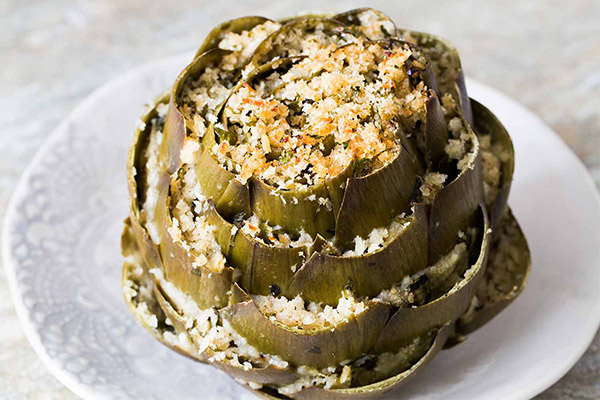
For cooking, we need:
- artichokes - 10 pcs.;
- white bread - 25 g;
- sunflower oil - 25 g;
- lemon - 1 pc.;
- dry white wine - 5 tbsp .;
- parsley - 2 stalks;
- salt and pepper - at the discretion of the hostess.
Cooking:
- Cut the lemon and squeeze the juice out of it into a pot of water.
- From the vegetable, remove the outer leaves, cut off the legs.
- We cut the artichoke along and remove the core from the vegetable. Sprinkle the vegetable with lemon juice and place in prepared water with lemon.
- In a separate pan, boil water, salt, pepper, if necessary.
- As soon as the water boils, we send the vegetables there and cook for 1 hour. It is important that artichokes become soft.To check readiness, you must try to tear off the leaf from the plant. If he easily leaves, then the artichoke is ready.
- We put the cooked artichokes on a dish. The cut side should be on top.
- Pour them with wine, sprinkle with oil, and sprinkle finely chopped greens and crumbs of white bread on top.
- Preheat the oven to 180 degrees. Put the artichokes in the oven for 20 minutes.
Fried artichoke
To prepare it, we need:
- artichokes - 2 kg;
- ham - 150 g;
- lemon - 1 pc.;
- parsley - 2 bunches;
- vegetable oil - 5 tbsp;
- salt and pepper to taste.
Cooking:
- Pour water into a separate bowl and squeeze out half of the lemon juice.
- From artichokes we cut off legs, we remove external rough leaves. Cut the vegetable along, then remove the core. Sprinkle artichokes with lemon juice and send into lemon water.
- Pour water into a saucepan, set on fire and bring to a boil. As soon as the water boils, put artichokes and salt in it.
- Cook over medium heat for 30 minutes, covering the pan with a lid. Artichokes should be soft, leaflets should be easily removed from the vegetable. This is the first sign that the artichoke is ready.
- Drain the water.
- In a pan, heat the oil, add the ham, cut into small cubes, there. Fry over low heat for 10 minutes.
- Finely chop the greens.
- We spread artichokes, fried ham on a dish and sprinkle everything with greens on top. Artichokes should be cut down.
Interesting Facts

- Vegetables should be eaten as soon as they are cut. Otherwise, they may lose their aroma, although they say that it can be stored in a cool place for a week.
- A variety of dishes are prepared from artichokes. You can use them both hot and cold. They are used as a standalone dish, side dish or salad supplement. With them you can cook pies, pizza, pasta, dessert and even bread.
- In order to cook artichokes correctly, a number of rules must be observed. It is important to know the intricacies of cleaning. For example, with large vegetables, before cooking, it is necessary to cut off the tips from the leaves. In addition, veins should be removed from the center of the leaves.
«Important: all information on the site is provided exclusively in fact-finding purposes. Before applying any recommendations, consult with a profile specialist. Neither the editors nor the authors are liable for any possible harm caused materials. "

